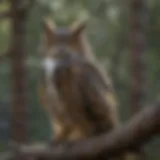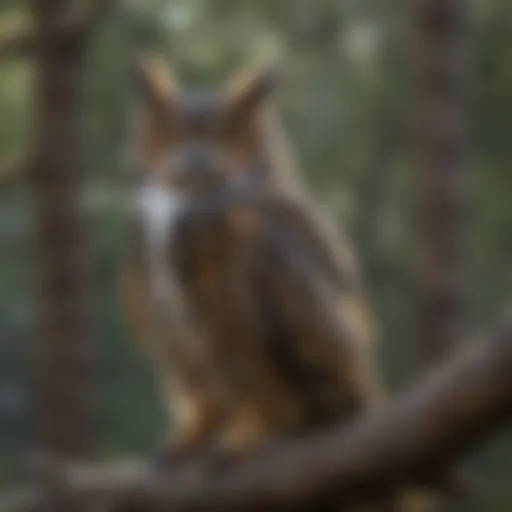Understanding Sloths: Nature's Unique Mammals
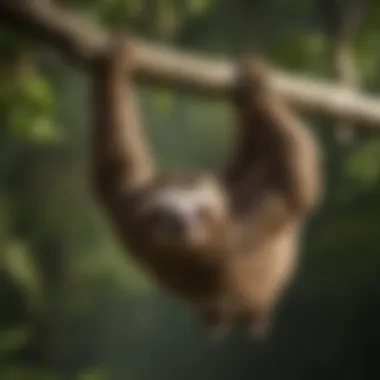

Nature Topic Overview
Sloths are some of the most unusual mammals on our planet. Found primarily in the rainforests of Central and South America, these fascinating creatures have adapted to their leafy homes in ways that are nothing short of remarkable. As we take a hefty dive into the lives of sloths, we're going to explore how their slow-paced lifestyle, unique physiology, and interesting behaviors set them apart from other mammals.
One vital aspect of understanding sloths is recognizing their role within their ecosystems. These mammals may seem lazy, but they're critical players in maintaining the balance of their natural surroundings. Through their specialized diets and interactions with other species, sloths contribute to the health of their habitats and help sustain the complex web of life around them.
Fun Facts and Trivia
To spark your curiosity, here are some fun tidbits about sloths:
- Three-toed vs. Two-toed: You might think all sloths are the same, but there are actually two main types! Three-toed sloths, like the Hoffman’s sloth, and two-toed sloths, including the Linnaeus's sloth, have different habits and appearances.
- Slow but steady: Sloths are famous for their slow movements. In fact, they can move as slowly as 0.03 miles per hour! That's slower than a snail on a mission.
- Algae in the fur!: Some sloths have green algae growing on their fur, which helps them camouflage themselves in the trees. This not only makes them look unique but also provides a meal for them!
"Sloths are masters of conservation—both of energy and their environment."
Wildlife Explorations
While sloths are intriguing all by themselves, they share their habitats with a plethora of other wildlife. They often coexist with animals such as:
- Capuchin Monkeys: Agile and social, these little primates love to snack on fruits and insects found in the same trees as sloths.
- Green Anaconda: The rainforests' waters hide these fascinating snakes, which can be spotted lounging around. However, sloths often remain high above in the trees, safe from them.
Want to check how much you know about animal facts? Try this quick quiz:
Q1: What’s the main diet of sloths?
Q2: Can sloths swim, and if so, how do they do it?
Environmental Awareness
Understanding sloths means recognizing their role in biodiversity. Their slow lifestyle doesn’t make them lazy; it allows them to conserve energy. As they munch on leaves, they help keep tree populations healthy. However, sloths face incredible threats due to deforestation and habitat loss. This is where we come in! Here are some tips kids can use to protect nature:
- Plant trees: Getting together to plant trees in your neighborhood can help make a difference in local habitats.
- Volunteer: Join a local wildlife organization. Many offer programs designed for young volunteers.
- Spread the word: Talk to your friends about sloths and the importance of all wildlife.
DIY Nature Activities
Are you ready to put your newfound knowledge to the test? Here are some fun activities you can do at home or outdoors:
- Sloth Slideshow: Create a slideshow showcasing photos of different sloths and their habitats. Draw your own pictures of sloths in trees!
- Plant a Garden: Start a small garden with plants native to your area. This helps local wildlife thrive!
- Nature Walk: Take a walk in a park and create a checklist of animals and plants you see.
These activities not only offer hands-on learning experiences but also connect you deeper with the natural world around you. Armed with this knowledge, you’ll become a better advocate for essential creatures like sloths and the ecosystems they help sustain. Let’s appreciate and protect our planet, one tree at a time!
Preamble to Sloths
Sloths capture the imagination with their unhurried movements and whimsical charm. But their world extends far beyond the adorable demeanor we often associate with them. Understanding sloths is not just about appreciating these cute creatures; it delves into the intricacies of their adaptations, habitat, and ecological significance.
Engaging with the topic of sloths opens up discussions on how life in the dense rainforests of Central and South America is shaped by unique evolutionary traits. From their specialized diets to their slow metabolism, sloths demonstrate remarkable adaptations that allow them to thrive in their specialized niches. For young learners and adults alike, exploring sloths introduces vital concepts such as biodiversity, environmental stewardship, and the balance of ecosystems.
As we venture into defining what a sloth truly is and unpack their evolutionary heritage, we not only gain insight into their biology but also foster a deeper appreciation for all living things that share our planet.
Defining the Sloth
Sloths are fascinating mammals that belong to the order Pilosa, and the suborder Folivora. They are known primarily for their sluggish lifestyle and unique body structure. What sets sloths apart is their long, curved claws, which enable them to hang effortlessly from tree branches. This leisurely life in the canopies allows them to avoid many ground-based predators.
A common misconception is that sloths spend their lives in a deep slumber. While they do sleep a lot—up to 20 hours a day—they are not entirely inactive. Their slow movements are a strategy for survival; being slow reduces their energy expenditure and minimizes the risk of detection by predators.
In simple terms, you can think of sloths as the ultimate chill-out artists of the animal kingdom. They embody the phrase "slow and steady wins the race," but make no mistake: their cool demeanor is a survival strategy.
The Evolutionary Background
The story of sloths stretches back millions of years. They have a rich evolutionary history that includes ancient relatives like the gigantic ground sloths, which lived during the Pleistocene epoch. These creatures were far larger than today's sloths, some standing as tall as a polar bear!
Modern sloths evolved around this time, adapting to the changing environment while shrinking in size. Today, two primary types of sloths exist: two-toed sloths and three-toed sloths.
Interestingly, sloths share a common ancestor with other mammals such as anteaters and armadillos. This surprising connection highlights the fascinating pathways of evolution and underscores the diversity of life on our planet.
In a world where many species have succumbed to extinction, sloths remind us that adaptation and resilience can pave the way for survival in the most unexpected places.
"Understanding the evolutionary background of sloths not only reveals how they came to be but also emphasizes the delicate balance of life that has allowed them to thrive in niche ecosystems."
In summary, knowing what defines sloths and their evolutionary journey helps us appreciate their role within the greater tapestry of life, making it essential as we navigate the broader conversations around conservation and biodiversity.


Physical Characteristics
Understanding the physical characteristics of sloths is essential as it not only helps us appreciate their uniqueness but also underscores their adaptations to life in the trees. Sloths are fascinating creatures, and their body structure is designed for a specific lifestyle that plays a critical role in their survival.
Distinctive Body Structure
Sloths have a body that stands out, making them easily recognizable. They have a chunky build with a short neck and large heads. Their limbs are long and slender, allowing them to hook onto branches with ease. The unique structure of their limbs is crucial for their slow-paced lifestyle. Each foot has three or two long, curved claws, which are their tools for grasping tree limbs, aiding their ability to hang upside-down for extended periods.
The sloth’s compact digestive system is another interesting feature. They have a low metabolic rate, which means they don’t need to eat a lot. This is also reflected in their diet of leaves, which are hard to digest. Their tummy is home to specialized bacteria that help break down tough plant fibers over long periods, often taking days to digest just one meal.
Despite their somewhat clumsy appearance, sloths are surprisingly strong and nimble when navigating their arboreal homes. Their muscular hind legs give them the strength required to cling to branches, while their small brains, though simple, are efficient for their needs. This distinctive body structure is critical to the sloth’s way of life, demonstrating how even nature’s quirkiest creatures are generally equipped perfectly for their survival.
Adaptations for Arboreal Life
Sloths are quintessentially tree dwellers, and their bodies have adapted magnificently for this habitat. Their claws, as mentioned before, act like hooks, allowing sloths to secure themselves to branches without much effort. This is especially useful as sloths spend most of their time hanging upside down, resting, or eating.
Moreover, the sloth's camouflage is a clever adaptation. Their fur often appears greenish due to algae growth, which not only provides a natural disguise against predators, but also offers a source of nourishment. Staying still for long periods also helps them conserve energy – an essential trait for survival in their nutrient-poor diet.
The low metabolic process of sloths means they move sluggishly. Predators such as jaguars or eagles might find it difficult to spot them in the trees, thus enhancing their chances of survival. The fact that they are built for life high in the canopy, along with their slow pace, means sloths are truly a marvel of nature’s design.
"The slow rhythm of sloth life teaches us the beauty of patience and the importance of balance in nature."
Understanding these physical traits tells more than just how sloths look; it reveals a compelling story of adaptation and survival. Their body structure and arboreal adaptations are not just for aesthetics - they are essential to thriving in their natural habitat.
Types of Sloths
Understanding the different types of sloths is like peeling layers off a complex and fascinating fruit. Sloths are not just a one-size-fits-all creature. They come with their unique traits and ever so interesting characteristics. In this section, we’ll explore the distinctions between two-toed and three-toed sloths, as well as where each type calls home. Knowing these differences can help us appreciate how these creatures adapt to their environments and how important they are to their ecosystems.
Two-Toed vs. Three-Toed Sloths
At first glance, the differences between two-toed and three-toed sloths may seem trivial, but there’s more than meets the eye.
- Physical Traits:
- Diet Variations:
- Behavior Patterns:
- Two-toed sloths, like the Linnaeus’s two-toed sloth, have only two long toes on their front limbs. This allows them to reach for food with ease, but they tend to be more agile than their cousins. Their fur is often light brown or grey and may host a variety of algae, providing perfect camouflage in the trees.
- Three-toed sloths, like the Brown-throated sloth, flaunt three toes on their front limbs. These guys generally have a darker coat and, interestingly enough, are known to be a bit slower than their two-toed relatives. The name speaks for itself; they simply have one extra toe!
- Both types munch on leaves, but two-toed sloths seem to enjoy a more diverse diet. They not only feast on leaves but also dig into fruits with gusto.
- Conversely, three-toed sloths stick primarily to leaves. They have specific trees they prefer, finding comfort and safety in familiar surroundings.
- The two-toed kind usually hang about in the trees, sometimes making a move during daylight hours.
- On the flip side, three-toed sloths are more nocturnal. They like to go about their business when the sun dips down.
Geographic Distribution
Sloths mainly call the lush, tropical regions of Central and South America their home, but they prefer different locales.
- Two-Toed Sloths are quite adaptable. They can be found in various habitats, yet they love to stick to humid rainforests. You’ll find them in countries such as Colombia and Brazil, enjoying the rich foliage. Their ability to adapt to both warm and slightly cooler climates ensures a diverse range of habitats. However, they often stay closer to the canopy, where they feel most at ease.
- Three-Toed Sloths primarily live in Costa Rica and other surrounding countries. They’re typically associated with tropical rainforests as well, yet they need specific trees for food. If you ever find yourself hiking through a rainforest, keep an eye out—you might just spy one hanging lazily from a branch, munching on leaves without a care in the world.
Understanding these types and their specific habitats helps underscore the importance of conservation efforts. Different sloths thrive in unique environments, and losing one could endanger the other. As we learn about these gentle creatures, we uncover the intricate web that connects them to other species and the delicate ecosystems they support.
"Knowing the types of sloths isn't just interesting; it's crucial for understanding how to protect them and their habitats."
As we venture deeper into understanding sloths, it becomes clear that each type plays a significant role in its ecosystem. Now, aren’t sloths something to ponder over?
Behavioral Traits
Understanding the behavioral traits of sloths helps us greatly in learning about how they interact with their environment and how they survive. These traits are key in showing us the unique ways in which sloths have adapted to their homes in the rainforest. They may seem slow and lethargic at first glance, but in reality, there is a lot of depth to their behavior that is essential to their survival and role in the ecosystem.
Dietary Habits
Sloths have a very specific diet that consists mainly of leaves, fruits, and flowers. They seem to have a keen sense of taste, choosing the best leaves available. Their slow metabolic rate means they only need to eat a small amount every day, which is quite unique compared to other mammals of their size. For example, a two-toed sloth will munch on the leaves of a cecropia tree, while three-toed sloths opt for liana vines that hang from the forest canopy.
Sloths have a fascinating relationship with their food. Their stomachs host special bacteria that help them digest tough plant material. This slow digestion can take days, which is why you might see a sloth hanging around one tree for an extended period. Because they can’t move fast to escape danger, having a low-energy diet suits them well.
In addition to their leafy meals, sloths sometimes consume fruits and even small insects, which helps them diversify their diet. This behavior aids in nutrient intake, making their meals not just filling but also necessary for their well-being.
Social Behavior
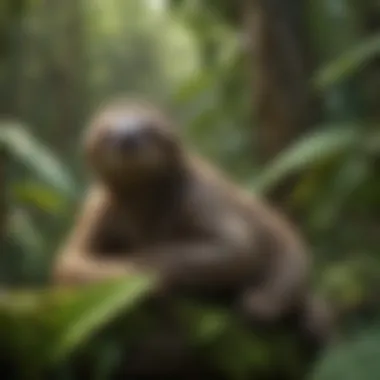

While sloths are generally solitary creatures, they do have social tendencies, particularly during mating seasons. They communicate with others through a series of sounds, scents, and body language. Mothers and their babies, for instance, share a very close bond. After giving birth, a sloth mother usually stays with her baby for about six months, teaching them essential survival skills.
Interestingly, sloths have also been known to interact with other species. You might find birds and insects hitching a ride on a sloth, forming a relationship that benefits both. The birds benefit by finding food, while the sloths get those pesky insects taken care of. This might not be considered a strong social bond, but it shows how sloths fit into a larger network of life in their habitat.
Movement and Activity Patterns
The movement of sloths is often characterized as slow—often described as deliberate or even lazy—yet there’s a method to their madness. Sloths are adapted to an arboreal lifestyle, moving primarily through the trees. Their strong limbs and long claws allow them to grip branches strongly, making their ascent and descent relatively safe despite their somewhat lumbering speed. Interestingly enough, even though they are slow on the ground, sloths swim surprisingly well. They can cover distances quickly when in water due to their long arms and buoyancy.
When it comes to activity patterns, sloths are mainly nocturnal, coming alive at night when the temperature cools down and predators are less active. During the day, a sloth typically hangs around in its chosen tree, resting for long periods. Their natural inclination to today’s heat makes them appear almost statuesque, blending perfectly with the trees.
"Sloths surprise us with their diverse, yet gentle lifestyles. Their slow and steady ways are actually – in their world – the best way to go."
All these behaviors paint a picture of animals that, while appearing quiet and still, engage in several activities crucial for their survival. Understanding sloths in this light allows us to appreciate their complexity despite their seemingly simplistic existence.
Habitat and Environment
Understanding the habitat and environment of sloths is crucial for grasping their unique lifestyle. These animals have adapted extremely well to the leafy canopies of Central and South American rainforests. Their home, rich in biodiversity and lush vegetation, plays a huge part in their survival as it provides them with food, shelter, and safety from predators.
Rainforest Ecosystems
Rainforests are vibrant ecosystems teeming with life, and sloths fit into this puzzle like a missing piece. These ecosystems are some of the most diverse on the planet, hosting countless species of plants, insects, and animals. Sloths predominantly rely on a specific diet of leaves, particularly from trees like the Brazilian nut and kapok trees. Their slow-moving lifestyle allows them to conserve energy while navigating these high branches.
- Trees Provide Food: Sloths dine mainly on leaves, which are abundant in their rainforest habitat. However, not all leaves are created equal. Some are more nutritious, helping sloths gain the bits of energy they need.
- Safety in the Canopy: Being high up in the trees is not just a luxury for sloths; it's a vital protective measure. Predators are much less able to reach them in the treetops, so they can eat without constantly looking over their shoulder.
Rainforest ecosystems also play host to a colorful mix of other critters, such as toucans and monkeys. All these species create a balance, helping each other thrive. Sloths, for their part, provide a home for algae that can grow on their fur. This relationship not only aids sloths by providing a form of camouflage but also feeds various insects like beetles – talk about a win-win!
Impact of Habitat Loss
Despite their adaptability, sloths are facing alarming threats due to habitat loss. Deforestation, primarily caused by logging, agriculture, and development, has led to a decline in their rainforest homes. The more trees that are cut down, the less food is available for these gentle creatures. Here's a look at some effects of habitat loss on sloths:
- Reduced Food Supply: With fewer trees around, sloths struggle to find their preferred leaves. This can lead to malnutrition, affecting their health and survival.
- Increased Competition: As their habitat shrinks, sloths may find themselves competing with other animals for limited resources, heightening the stress on these slow-moving mammals.
- Isolation: Fragmented habitats can lead to sloths being cut off from one another, reducing their ability to mate and thus affecting population stability.
"Conserving rainforests not only helps sloths but is vital for many creatures that depend on these ecosystems. Each species, including sloths, plays its role in maintaining the balance."
In summary, sloths are not just a wonderful example of evolution but are also a vital part of their ecosystems. Understanding their habitat sheds light on the challenges they face and the importance of conserving these rich environments. When we protect their home, we protect the many other species that share that space, creating a healthier planet for everyone.
Ecological Role of Sloths
Sloths play a significant role in their ecosystems, acting as both contributors to and indicators of environmental health. Their slow-paced lifestyles and specialized diets have shaped how they interact with their surroundings, making them a vital part of the cloud forests and tropical rainforests of Central and South America. Understanding the ecological role of sloths can help highlight the intricate balance within these ecosystems and the need for their protection.
Sloths and Their Role in the Ecosystem
Sloths are often seen as the furniture of the forest, but their contributions go far beyond just hanging around. By feeding primarily on leaves, they help to manage and regulate the plant life in their habitat. When they munch on leaves, they do not only consume—but also affect—the growth patterns of trees. Their foraging habits can promote the growth of certain plants while keeping the overall plant community healthy.
Moreover, sloths contribute to the nutrient cycle. Their droppings, which are high in nutrients, become a valuable source of food for various insects and plants. The seeds found in their feces can also give rise to new plants, making sloths essential for forest regeneration. Their presence in the forest contributes to biodiversity, supporting a wide variety of life.
"Sloths may be slow, but their impact is far-reaching, affecting everything from plant health to soil quality."
Additionally, sloths are indicators of environmental health. A thriving population suggests a well-balanced ecosystem. If sloths appear to decrease in number, it often signals larger issues within their habitat, such as deforestation or climate change. Thus, observing sloth behavior and population size is crucial for conservation efforts.
Symbiotic Relationships
Sloths have a unique way of life that drives various forms of symbiotic relationships in their ecosystems. One of the most remarkable aspects is the relationship sloths have with their fur. They host a variety of microorganisms, including algae that grow on their fur. This not only offers camouflage against predators but also provides nutrients for the sloths. The algae thrive in the warm, sheltered environment of the sloth's fur, and in return, they may contribute to the sloth's health.
Beyond algae, sloths support the entire web of life within the tree they inhabit. Many creatures, such as insects, birds, and even mammals, find homes, food, or protection in their fur or the branches they rest upon. For example, some species of beetles and moths are specially adapted to live among the leaves of trees that sloths frequent.
This relationship shows how interconnected life can be in the forest. Every organism, even the slow-moving sloth, plays a crucial role in maintaining the balance of their ecosystem. Recognizing these connections helps deepen our understanding of biodiversity and the importance of conservation efforts.
In summary, sloths may appear languid and solitary, but their ecological role speaks volumes to their importance within the habitat. They support plant growth, enrich the soil, serve as indicators of ecological health, and provide shelter for a variety of other species—all key factors in maintaining a healthy and balanced ecosystem.
Conservation Status
Conservation Status is a vital topic when it comes to understanding sloths. These gentle creatures have found themselves in a precarious situation. Their slow movement and unique lifestyle, while intriguing, make them particularly vulnerable to changes in their environment. As we explore the threats they face and the efforts being made to protect them, it's key to realize how interconnected all aspects of nature are. Sloths play an important role in their ecosystems, and any decline in their population can ripple through their habitats.
Threats Facing Sloths
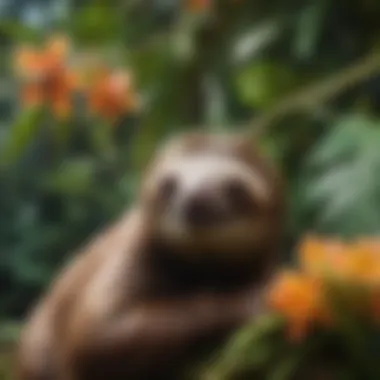

The challenges sloths encounter are numerous and severe. Here are some of the main threats:
- Deforestation: Trees are sloths' homes. When people cut down forests for wood or land for agriculture, sloths lose their living space. This not only endangers their habitat but also exposes them to predators.
- Climate Change: Changing weather patterns affect sloths’ habitats. Weather extremes can alter the growth of foliage, which is essential for their diet, and shifting habitats may not support the sloths' unique needs.
- Illegal Hunting: Although not as widespread as other threats, some sloths are captured illegally for the exotic pet trade or bushmeat markets. This has a dire impact on local populations and disrupts the natural balance of their ecosystems.
"If we don't take care of our forests, we're not just losing trees; we’re losing the animals that depend on them, like sloths."
Conservation Efforts
Fortunately, there are many dedicated individuals and organizations working to conserve sloths and their habitats. The following efforts highlight the importance of teamwork in preserving these unique mammals:
- Protected Areas: Establishing national parks and reserves helps keep sloths safe. Areas like Manuel Antonio National Park in Costa Rica provide a safe haven for these creatures, allowing them to roam freely without the threat of habitat destruction.
- Reforestation Projects: Organizations often plant trees in deforested areas to restore habitats. By replanting these essential trees, they are giving sloths—along with other species—a second chance at a healthy home.
- Education and Awareness: Teaching local communities about the importance of sloths and their role in the ecology encourages them to protect their surroundings. Schools and NGOs sometimes launch campaigns to foster greater appreciation for wildlife.
- Research Initiatives: Studying sloth behaviors and habitat needs gives conservationists the knowledge necessary to develop effective protection strategies. Understanding how sloths interact with their environment is key to ensuring their long-term survival.
Cultural Significance
Understanding the cultural significance of sloths adds a rich layer to our appreciation of these unique mammals. Culturally, sloths have been woven into the fabric of folklore, stories, and even modern media, serving as symbols and characters that reflect various human values and norms. They are not only fascinating animals but also hold a mirror to how societies see nature and their relationship with it.
Sloths in Folklore
In many cultures, sloths appear in folklore and stories, often embodying traits that people respect or aspire to. For example, in some South American legends, sloths are seen as wise creatures that bring peace and tranquility to the jungle. They might be depicted as guides for lost souls, teaching patience and the importance of taking life slowly.
In Brazil, traditional tales portray the sloth as a friendly being who teaches children about the rainforest's ecosystem. These stories emphasize the balance of nature and encourage younger generations to respect wildlife. The messaging is straightforward: the slower pace of sloths reminds us that rushing through life isn’t always the best approach; sometimes, taking it slow can yield the most fulfilling experiences.
"In the stories of the Amazon, the sloth reminds us of the beauty in stillness and patience."
Representation in Media
In addition to folklore, sloths have made a significant impact in contemporary media. Popular cartoons and movies often use sloths to provide comic relief, serving as relatable characters that reflect a laid-back attitude. The character Sid from the movie Ice Age exemplifies this perfectly, portraying a loveable yet goofy sloth who often finds himself in entertaining predicaments. This representation resonates with children, making sloths seem approachable and fun.
Furthermore, social media platforms often showcase captivating images and videos of sloths, enhancing their popularity among younger audiences. They capture attention with their slow movements and adorable faces, making them perfect for viral content. This exposure cultivates a sense of wonder about wildlife, inspiring children and their families to learn more about these fascinating mammals and their environments.
In essence, the cultural significance of sloths extends beyond their biological attributes. They are a blend of wisdom and whimsy, urging us to appreciate the slow, quieter moments of life while raising awareness about the natural world around us.
Fun Facts About Sloths
Learning about sloths might not just be fascinating;it can also help young minds appreciate the wonders of our planet. The unique traits and behaviors of sloths make them more than just slow-moving creatures in tree tops. Understanding these quirks can unlock a lot about their ecological role and our shared world. Recognizing why they cannot be all just about lounging around helps kids see the importance of every creature in the ecosystem. They teach us lessons in patience and adaptability that apply to many areas in life.
Interesting Sloth Trivia
There is much to impress and delight about sloths. Here are some fun tidbits that highlight their uniqueness:
- Slowest Mammals: Sloths are known as the slowpokes of the animal world. They usually move at a leisurely pace of about 0.03 miles per hour. Some folks might joke that even a snail could pass them up, but this slow lifestyle allows them to save energy and blend in with tree canopies.
- Three-toed and Two-toed: You may have heard about the two types of sloths — the two-toed sloth and the three-toed sloth. What's interesting is that despite the names, the differences go beyond just the number of toes; their behaviors and habitats vary too, revealing two distinct ways of life.
- Incredible Digestion: Sloths have a very slow metabolism, taking up to an entire month to digest food! This means they do not need to eat much each day. They mainly munch on leaves, which are pretty tough to break down anyway. It’s like a slow cooker in the forest!
"Sloths digested food so slowly that they may be the dreamers of the rainforest, living in a world of their own in a slow and steady manner."
- Algae Love: Many people might not know that the fur of the sloth hosts a type of algae. It isn’t just for decoration; this green growth provides them with some camouflage against predators and keeps them blended with their leafy surroundings.
- Quality Nappers: Do you know how many hours sloths sleep? They can snooze away for about 15-20 hours a day! This allows their bodies to conserve energy for their slow lifestyle. It sounds like a dream job, doesn’t it? But that’s nature's way of giving them the advantage they need.
Misconceptions About Sloths
When it comes to sloths, many people hold onto some misconceptions. Clearing these misconceptions can help us understand these unique animals better:
- Not Lazy, Just Efficient: It's a common belief that sloths are lazy. In actuality, their slow movements are a clever adaptation to conserve energy and avoid predation. They aren’t lazy; they’re just masters of energy management, which is fascinating by itself.
- Swimming Skills: Contrary to popular belief, sloths are actually pretty good swimmers. They can hold their breath for up to 40 minutes and use their long limbs to paddle through water. Their capacity for swimming allows them to cross rivers, accessing new areas and food sources.
- Not Always Hanging Upside Down: Many might think sloths spend their entire lives dangling from trees. They do rest in a hanging position, but they can also be found curled up or seated in branches. Their ability to orient themselves in various ways showcases their adaptability.
- Different Sounds, Different Messages: People often think sloths are silent creatures. In reality, they can communicate through a series of vocalizations, especially when they are in distress or trying to warn others. This aspect adds another layer to their personality that’s often overlooked.
- Algae is Not a Food Source: While sloths often host algae in their fur, it's crucial to note that they don’t eat it. They rely heavily on the leaves and fruits from specific trees. Everything in their ecosystem has a role, but cultivating algae isn’t one of theirs; it’s more of an interesting fact than a dinner option.
By delving into these fun facts and addressing the misconceptions, we not only appreciate sloths more but also encourage curiosity and understanding about the natural world. Whether through trivia or challenging prevalent beliefs, each piece of knowledge makes a significant impact.
Finale
As we reach the end of our journey into the world of sloths, it’s important to reflect on their significant role in nature and our responsibility to protect them. Sloths might seem slow and lazy, but they harbor a wealth of biological secrets and ecological importance that holds value far beyond their apparent simplicity. This article has journeyed through their unique adaptations, interactions within the ecosystem, and the threats they face in modern times.
Recap of Sloth's Importance
To wrap it up, here are three key points about why sloths are vital:
- Ecosystem Balance: Sloths contribute to the health of their surroundings. They help with vegetation, allowing trees to thrive that young animals may depend on for homes.
- Biodiversity: The presence of sloths in their habitats encourages a diverse range of species to flourish. Varieties of plants and animals coexist in harmony, showcasing the beauty of biodiversity.
- Cultural Symbol: Beyond their ecological role, sloths also symbolize a deeper connection to nature. They remind us to slow down and appreciate the world around us, a valuable lesson in today’s fast-paced society.
In essence, sloths are more than just adorable creatures; they are critical players in maintaining biodiversity and ecosystem stability.
Encouragement for Future Learning
Looking ahead, it’s vital to continue learning about sloths and their specific needs.
- Support Conservation Efforts: Understand how to advocate for sloth conservation. Join local groups or follow related organizations on platforms like Facebook to get involved.
- Explore More: Children and adults alike can seek out books and documentaries that delve deeper into these fascinating creatures. Platforms like Wikipedia and Britannica offer rich resources that will expand your knowledge.
- Discuss and Share: Talking about sloths among friends and family can spark interest in environmental issues. Discuss what you’ve learned and inspire others to have a heart for these unique mammals.




